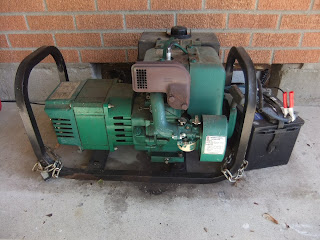My short answer is that if you want to learn how to work on small engines, dive in! I like the youtuber "donyboy73" .
http://www.youtube.com/channel/UC6MEb54vwjicHs7L39sS4hA
If it had old gas in it, it might need a carb rebuild, which isn't too difficult.
You'll have to troubleshoot it and decide whether you want to repair it or use it for parts.
If you don't want to be a small engine mechanic then you should probably sell the generator(s) and buy what you need.
A more compatible energy source for a genset may be a biogas producing "digester" (anerobic composting), or a woodgas gasifier.
A wind turbine that can produce multiple horsepower sufficient to run this generator will be quite large, and so will the tower to put it on. That may be your limitation. I'm skeptical of the claim that the generator requires unusually high starting torque. I think it probably does require a lot of torque at normal operating speeds, but I think that's because it is a multi-horsepower generator, not because of some unusually high dead-load (zero-speed torque load). Gearing it down by 4:1 would *increase* the torque, and should make it *more* likely to run, not less. Although a better answer is that power-transfer is maximized through impedance matching. That's just a fancy way of saying "pick the right gear-ratio".
If you're familiar with the multi-vane (water-pumping) windmill that became an icon of the rural american landscape, one of its characteristics is relatively high torque in low wind speeds. It will have a lower minimum windspeed at which it starts turning. While the design doesn't produce as much energy overall as a modern 2 or 3 blade horizontal-axis wind turbine (HAWT), it does produce small amounts of power more often, which can be more useful for off-grid applications, given that most of the time windspeeds are low, and energy storage is often expensive. A Savonius type is like that as well. And there are other VAWTs like it, including one that came out recently.
Wind energy has a lot of appeal, but justifying it tends to require surprisingly high windspeeds and/or lower power requirements, especially with small turbines that cost more per watt than the megawatt sized ones. If you live on a coastline or on a mountain, great. If I was on a sailboat I would get one. However, solar cells are getting so affordable that I think small wind generators will have a tough time competing. Biogas and woodgas can probably produce a lot more energy where load-requirements are in the HP or kW range.
I think small-scale wind energy has to be justified some other way, either as being low-maintenance, or as a way to diversify energy sources in order to reduce storage requirements, or for an emergency source in situations where weather-related natural disasters might tend to be more windy than sunny. Unfortunately, even then it's not as reliable as one might like, since a storm that can knockout the grid can also knockout a wind turbine, unless extreme protective measures are taken to prevent storm-damage. That seems like a situation where something like a large battery, or a solar cell or a fuel cell seems like it would be much more reliable.






 4
4




 4
4




 3
3




 1
1








 2
2




 1
1












 2
2









 4
4




 3
3








 1
1




 2
2










